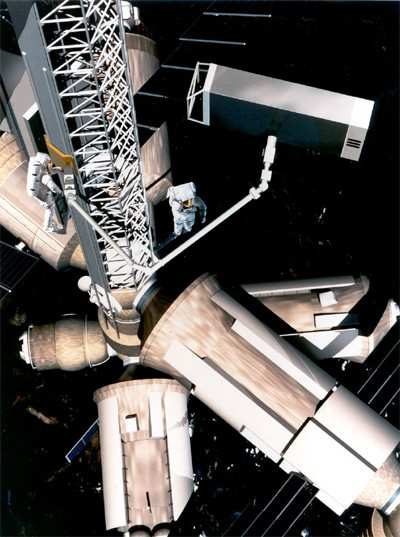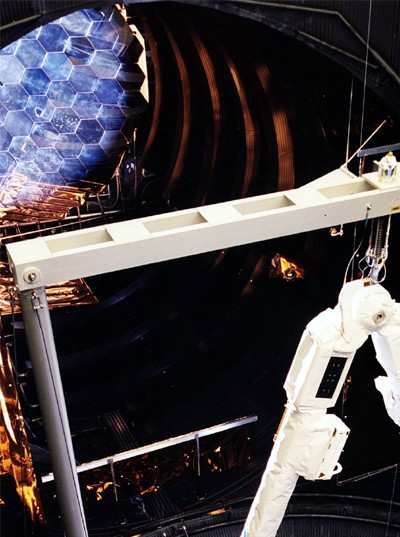Will Build European Robotic Arm For International Space
Station
It's a done deal. ESA's Director of Human Spaceflight,
Microgravity and Exploration, Daniel Sacotte Thursday signed a
contract for the launch preparations and first operations of the
European Robotic Arm (ERA) on the International Space Station
(ISS). The contract, worth 20 million Euro, was signed with Dutch
Space, the Industrial Prime Contractor leading an industrial
consortium of European companies. The contract signing took place
at the Erasmus User Center at ESA's European Space Research and
Technology Center (ESTEC) in Noordwijk, the Netherlands.

Originally ERA was scheduled for launch on a Space Shuttle,
together with the Russian Science and Power Platform, which was
intended to become its home base for operating on the station. Last
year Russia introduced the Multipurpose Laboratory Module (MLM) as
a new module to be added to the ISS and proposed also the
possibility that ERA could be installed, launched and operated on
the MLM. Since the MLM is designed for launch on a Russian Proton
rocket, ERA will no longer be carried into space on a US Space
Shuttle, but aboard Proton, This requires some technical,
operational and contractual re-arrangements between the parties
involved.
Under the contract the now signed the consortium led by Dutch
Space will requalify the ERA flight and ground segment for a launch
on Proton and will deliver the ERA hardware to Russia. The
consortium will also implement ERA training for the Russian
cosmonaut instructors and will support the training of the Russian
cosmonauts on ERA operations. It will also support ground
processing and launch preparations in Russia. This will take place
at various locations: at the Khrunichev premises, where the Proton
launcher is built; at Energia, which together with Khrunichev
builds the Multipurpose Laboratory Module; at the Gagarin Cosmonaut
Training Center in Star City; and at the launch site in Baikonur.
Under the new contract, in-orbit validation of the robotic arm is
the final activity to be performed by the consortium. This involves
participation in, and analysis of, the first operation of ERA after
launch when the performance of ERA will be validated under real
space and operational conditions.

"The European Robotic Arm is a good example of how spaceflight
is driving new technologies," says Sacotte. "Through spaceflight we
have been building up expertise in key technologies like robotics,
which is not only beneficial for Europe and European industry but
also demonstrates the important role Europe is playing in the
International Space Station program by contributing key elements
such as the Robotic Arm."
The European Robotic Arm is over 11 meters in length and weighs
630 kg. ERA is capable of moving payloads up to a total mass of
8000 kg and is able to position itself with an accuracy of 5 mm. It
will be launched from Baikonur to the ISS on a Russian Proton
rocket in November 2007. For the launch ERA will be mounted on the
new Russian element to be incorporated in the International Space
Station - the Multipurpose Laboratory Module - which will then
become the home base from which ERA operates. With its seven joints
and an impressive concentration of tools and electronics, the arm
can move hand-over-hand between fixed base points around the
Russian ISS segments and will be used for a variety of tasks.

ERA can be used to install, remove and deploy solar arrays and
radiators and can, via the new Russian equipment airlock, transfer
small payloads from inside to outside the ISS and vice versa. This
will reduce the time needed for extravehicular activities to the
absolute minimum and save the crew having to perform preparatory
tasks like carrying payloads out of or into the ISS. Another
important task for ERA will be to transport astronauts from the
airlock to the position where they are supposed to perform their
work, which again saves time and effort. ERA is equipped with four
cameras and lighting units, which provide for thorough inspection
of the ISS.
The European Robotic Arm can be operated from inside the ISS.
However, an astronaut outside the station can also drive the arm
while performing Extravehicular Activity. Once installed on the
International Space Station ERA will be operational in the harsh
environment of space for at least 10 years.
 ANN's Daily Aero-Linx (04.13.24)
ANN's Daily Aero-Linx (04.13.24) ANN's Daily Aero-Term (04.13.24): Beyond Visual Line Of Sight (BVLOS)
ANN's Daily Aero-Term (04.13.24): Beyond Visual Line Of Sight (BVLOS) Airborne 04.09.24: SnF24!, Piper-DeltaHawk!, Fisher Update, Junkers
Airborne 04.09.24: SnF24!, Piper-DeltaHawk!, Fisher Update, Junkers Aero-News: Quote of the Day (04.14.24)
Aero-News: Quote of the Day (04.14.24) ANN's Daily Aero-Term (04.14.24): Maximum Authorized Altitude
ANN's Daily Aero-Term (04.14.24): Maximum Authorized Altitude





